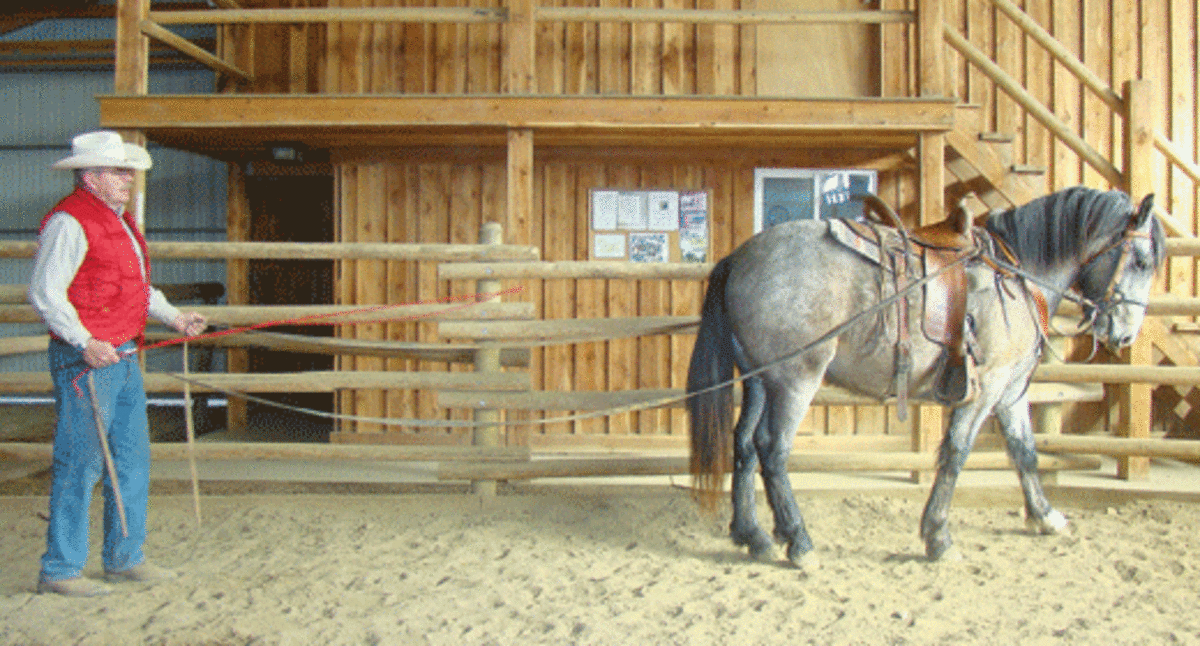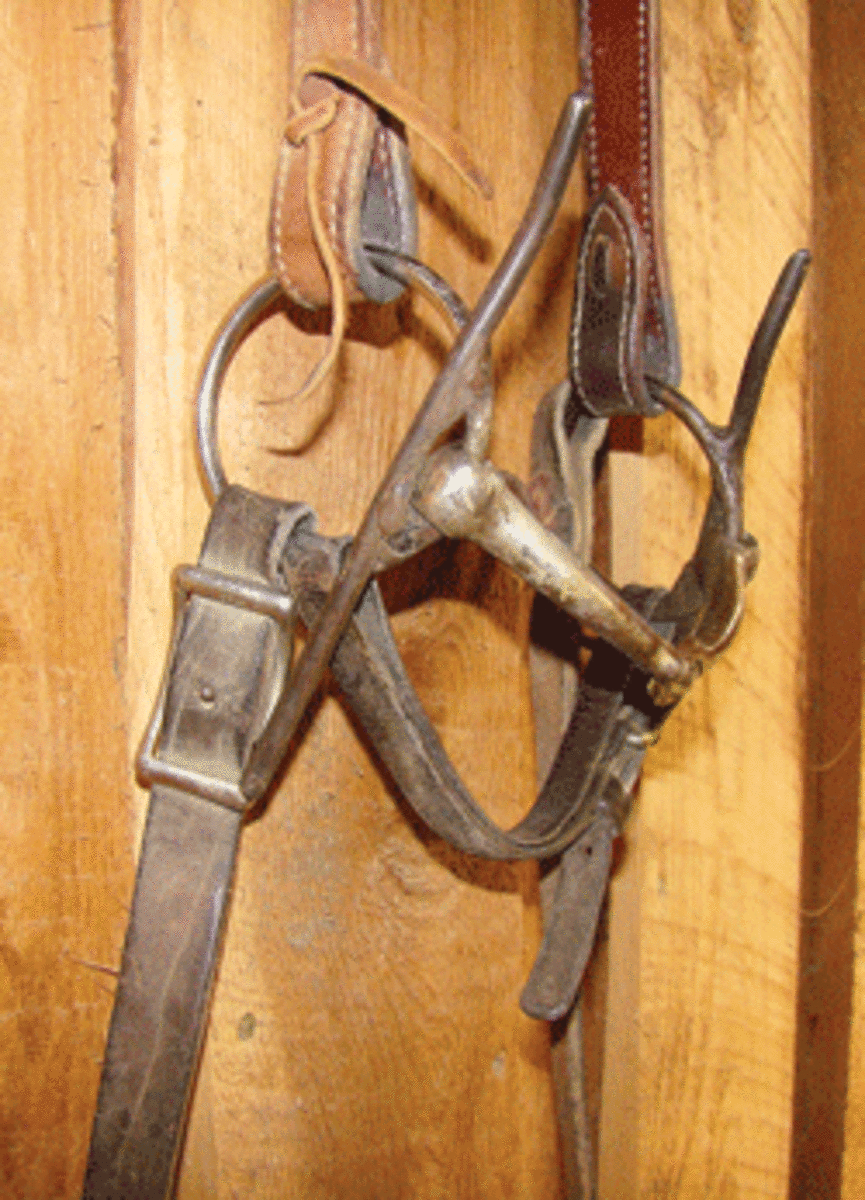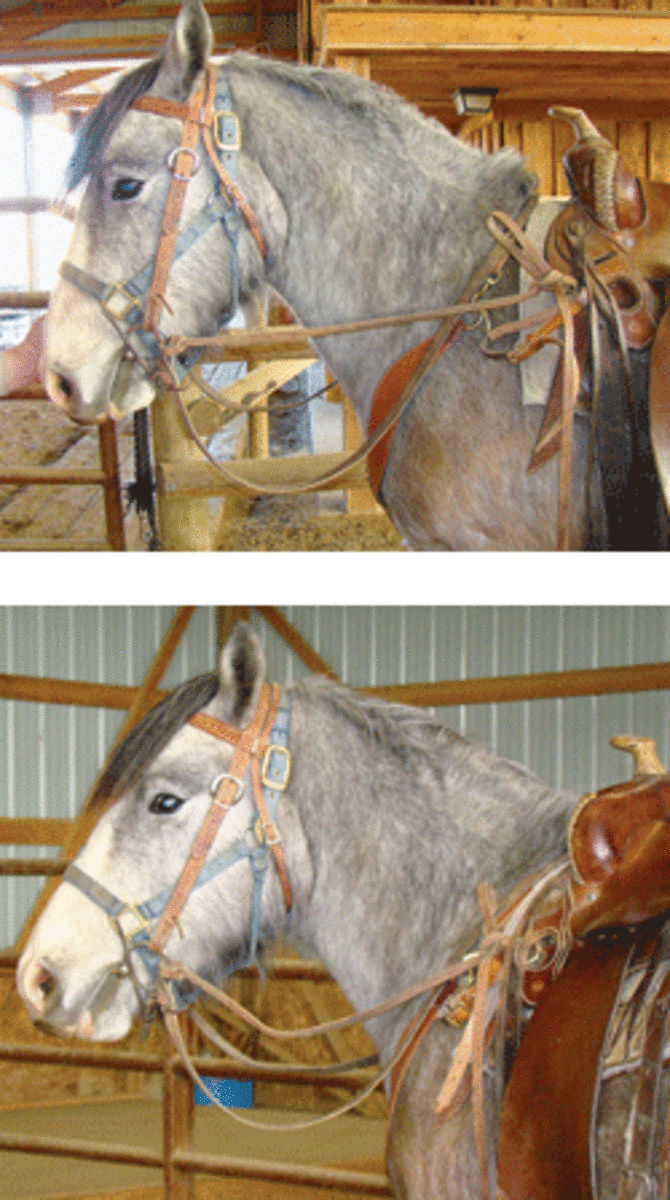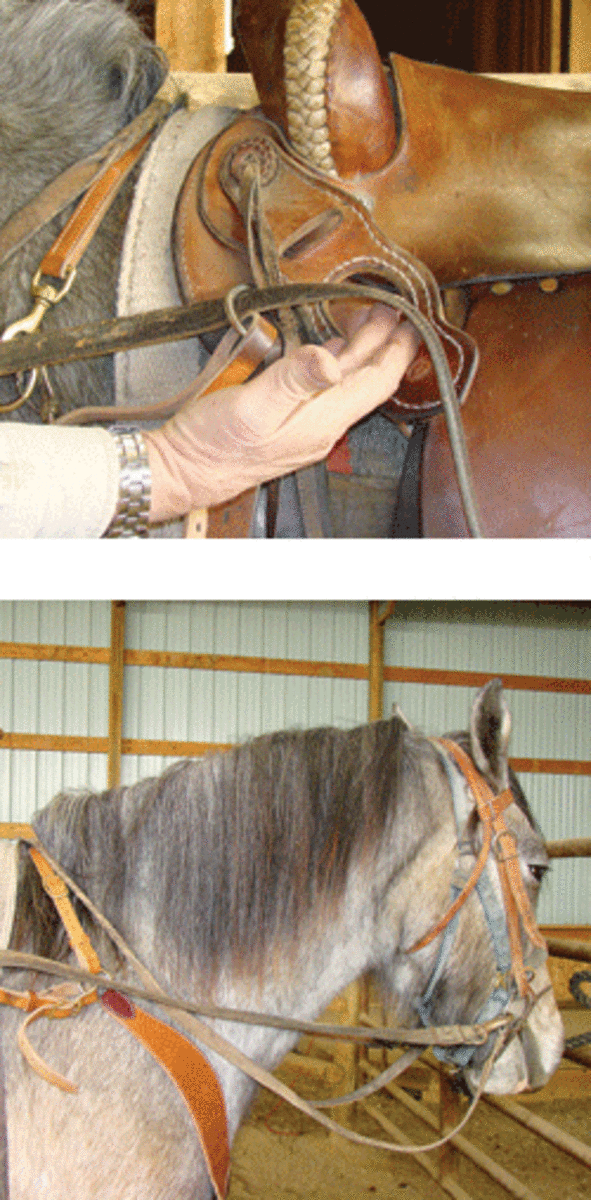
Ground-driving has been a successful training technique for centuries, and in a wide variety of disciplines. For instance, trainers at the famous Spanish Riding School in Vienna rely on ground-driving to teach their Lipizzaner stallions essential lessons on their way to advanced dressage.
Ground-driving pays many dividends later on the trail, even for the horse never destined to pull a buggy. The colt mentioned above, a Belgian/Tennessee Walking Horse cross (ironically named Trouble), was slated to become an all-purpose horse for riding, packing, and harness work. But every horse I train, including those destined for saddle alone, experiences being driven and signaled from behind.
What Driving Teaches
Ground-driving is one of the best ways to teach “whoa” and “back,” to teach a youngster to listen for your signals, and to turn right and left with subtle rein pressure. All this can be done before he’s mature enough to carry a rider.
A young horse thoroughly trained to ground-drive is often a safer animal when the time arrives for that first ride. He already thoroughly knows the basics of impulsion and direction, and he’s been taught a positive “whoa.” He’s become entirely used to long reins rubbing his rear, to sounds behind him, to the slapping of stirrup leather and the press of the cinch as he moves.

Ground-driving is also an ideal way to teach a young horse to carry weight long before a rider mounts him, particularly if you use a pack saddle for the purpose. I’m far more confident mounting a colt for the first time if he’s already experienced carrying weight on his back. My favorite load for a young animal is 100 pounds of feed or granulated salt, one 50-pound sack on each side, enclosed in cloth panniers.
Beginnings
Ground-driving comes after several sessions accustoming the youngster to my usual routine. I curry, rub with a blanket, pass ropes over his body, pick up his feet, and teach him to lead by each foot.
Many methods work, and any gentle-but-firm routine for starting a young horse will ready him for ground-driving, with a couple of caveats. Impulsion must be taught, whether with signals from a longe whip or the long lead rope commonly favored today.
Too many inexperienced trainers aren’t assertive enough when teaching impulsion. If a spank on the rear is required to send your horse forward, use it: training can’t progress without your horse understanding impulsion.
Much training today centers on having the horse face the trainer. But taken too far, this can cause problems for the driving horse. I once worked with a very large, very nervous Thoroughbred/Belgian cross that had been trained, probably with some severity, to face the trainer above all else, to never turn his rear toward the person in the round pen. Thus, his answer to every insecure moment was to whirl and face me. Training him to drive, to tolerate my presence behind him, stressed the limits of my patience and nerve.

Tack You’ll Need
Your tack room probably already contains most of what you’ll need to ground-drive your young horse. A training surcingle, simply a band that encircles the horse’s chest, is inexpensive and handy, but certainly not required. Replete with many D-rings, the surcingle allows several options in adjusting the angle of the driving reins.
But a pack saddle, either a sawbuck or a Decker, will do just fine, as will an everyday Western saddle. Driving reins, long straps with snaps on the end, are fine, if available. If not, two light longe lines will work as reins. It’s also easy to make up a pair with light poly ropes, perhaps 25 feet in length, a snap eye-spliced into the end of each.
Some trainers prefer to begin driving with halter alone, but I use a home-built version of the full-cheek snaffle. This snaffle has bars that lay vertically along the sides of the horse’s mouth welded to the bit rings. These bars distribute pressure on the cheek on the side away from the turn, so that the pull is gentler on the mouth.
The Bit Yield
Before you drive your young horse, teach him to yield to the bit. Otherwise, the driving process will likely be hard on his mouth. Trainers have many methods for accomplishing a soft, yielding mouth, but I’ve always believed that horses, like people, learn best from lessons they teach themselves.
A young horse will “self-teach” yielding to the bit while you enjoy a cup of coffee if you use the old method of tying around. This technique entails tying a single rein from the bit ring back to the saddle until the horse learns to yield to it, then repeating on the other side. However, this must be done correctly, or you’ll do your youngster more harm than good.
Too often I’ve seen trainers attach a rein to the bit ring, pull the horse’s neck to the side into a tight arc, then tie it off to the saddle. The horse turns round and round in discomfort, perhaps stressing his mouth, perhaps fighting this uncomfortable posture into which he’s been forced by bucking or rearing.
Unable to get relief from the tension, because he’s already been pulled around as far as his neck allows, the horse doesn’t learn how to release himself from pressure. The trainer has missed the entire point.
Instead, tie the rein so that all slack is taken out when your horse’s neck is in the straight-forward position. Perhaps take just an inch more slack, then tie it off to the saddle with a quick-release knot.
Now, we have a perfect self-teaching scenario. When the horse’s head is straight forward, he feels tension on the bit, and he rapidly learns that turning his head and bending his neck slightly to that side relieves all pressure. He’s still comfortable, but he’s taught himself to yield to the bit. Most youngsters will make this adjustment very rapidly and stand with the rein completely slack. When your horse has learned this lesson on one side, repeat the process on the other side.
Trainers oriented toward extremely low head carriages often tie the rein to the cinch ring. I prefer to tie it off at about the same height as the horse’s natural head position, perhaps to the ring at the top of the latigo (or billet on the off side). A surcingle or pack saddle has more options; you can also add extra D-rings to your riding saddle.

Driving Technique
A round pen is ideal for your youngsters’ first driving lesson, particularly if he’s already been taught to longe. I usually tie the colt to a post while I rig each rein from his bit back through a D-ring, laying them on the ground alongside and extending behind him where I’ll be able to pick them up.
Some trainers thread the reins through the stirrups, first tying a cord between the two stirrups under the colt’s belly to prevent them from flopping around. That makes for a point of attachment a little too low for my liking. I’ve also threaded the reins through the stirrup leathers above the stirrups, which works, though they’re not as free from friction as I like.
Since the colt already has a concept of “whoa,” I ask him to stand. Then I detach his lead rope from his halter, and walk back and pick up the reins, clucking him forward and touching his rump with my longe whip, if necessary.
For safety, stay back out of the kick zone, and be extremely careful not to wrap the reins around your hand or let them entangle your feet. Move your horse around the round pen, keeping some rein contact, not allowing him to stop unless on your command. If he’s used to being longed, he’ll probably take to this readily. For him, it’s merely a matter of being longed with somewhat different tack. Progress to turning, stopping, and backing.
I work to accustom my colts to gentle signals to move out. A clucking sound accompanied by picking up the reins (taking out the slack) is soon all that’s necessary. Earlier, I may have to snap my whip or (rarely) touch it to the colt’s rear.
Forget the Western movie stereotype of slapping the horse’s rear with your reins. No good teamster does that. Using the reins for impulsion sends mixed signals to your youngster, because, while feeling the slap on his rear, he also feels jerking on the bit.
Don’t be subtle when handling the reins on turns. One difference between driving and riding is that the driven horse needs to be given slack with one rein while the other is tightened. If you rein your horse left by gathering a certain length of rein, an equal amount of rein must be given back to him on the right side. Get used to a deliberate withdrawal of one arm, accompanied by an extension of the other arm, each time you turn.
Also, try to avoid excessive “belly” in the rein. Maintain some contact. The reins will sag from their own weight, but don’t strive for a completely “loose” rein. For many reasons, teamsters consider excessive slack to be dangerous.
With most young horses, there will be mishaps along the way. But if you’ve prepared your horse properly, they’ll likely be modest ones. He might step over a rein so that it runs back between his hind legs, but that’s no call for panic. Usually, you can stop him, let the offending rein rest on the ground, and get him to move his rump to the side, stepping back over the rein.
Occasionally, a frightened horse will whirl around, tying himself up with the reins. Let him figure out that he’s all tied up. Then reattach the lead rope to the halter, and straighten out the mess.
Further Lessons
Even if you’re quite certain you’ll never use your horse in harness, teaching him to pull a load that scrapes along behind him is great training, and it might just come in handy someday.
Training your horse to pull a load while being driven is great preparation for dragging a load from the saddle horn later on. A friend saved her buddy’s horse from a bog by rigging two improvised traces to her horse’s breastcollar, hooking on to the saddle horn of the helpless horse, and pulling it free. She credited early training to ground-drive for her horse’s behavior during this stressful situation.
To pull a light load behind your ground-driven horse you don’t really need a proper harness, though that’s best if you have one. As long as your riding saddle or pack saddle has a breastcollar it’s not hard to rig a couple of traces (also called tugs) back from the breastcollar to a modest, safe load, such as a tire from a small car. Be extremely careful that your driving reins are long enough to allow you to walk behind the load.
When your horse tolerates the feel of pulling a load and the sound of the load’s progress behind him, you’ve trained yourself a far safer horse, less likely to spook blindly at sudden noises behind him.
You’ve also made your horse more useful whether for dragging a snag of wood in to the campfire area or, when he’s exceedingly well trained, pulling the kids on a sled.
Along the way, there’s nothing wrong with teaching your youngster the teamster’s terms “gee” for right and “haw” for left. Simply say them each time you turn. Even in an animal destined only for the saddle, knowing these terms could come in handy someday.
Old Horse, New Tricks
Old horses most certainly can learn new tricks, and there’s no reason a similar training approach can’t be applied to your gentle older horse if, perhaps, you wish to train him to pull a buggy or a sled.
I don’t think you’ll ruin your older horse’s neck rein by going back to a plow reining routine, but it’s extremely important to go back to the snaffle bit if he’s progressed to a curb or other leverage device. He’ll associate his riding bit with his training in neck reining but will likely remember his earlier snaffle training while in the driving situation.
Ground-driving pays dividends, whether to make your saddle horse a more useful animal or to make him more unflappable on the trail, Besides, it’s fun!
Dan Aadland (https://my.montana.net/draa) raises mountain bred Tennessee Walking Horses and gaited mules on his ranch in Montana. His most recent books are The Best of All Seasons, The Complete Trail Horse, and 101 Trail Riding Tips. Sketches from the Ranch: A Montana Memoir is now available in a new Bison Books edition.




